This Vegetarian Japanese Curry is loaded with thick, meaty slices of king oyster mushrooms and colorful vegetables like kabocha, eggplant, and asparagus. With homemade Japanese curry roux, this dish is no doubt our family’s favorite for a bright and flavorful dinner! {Vegan Adaptable}
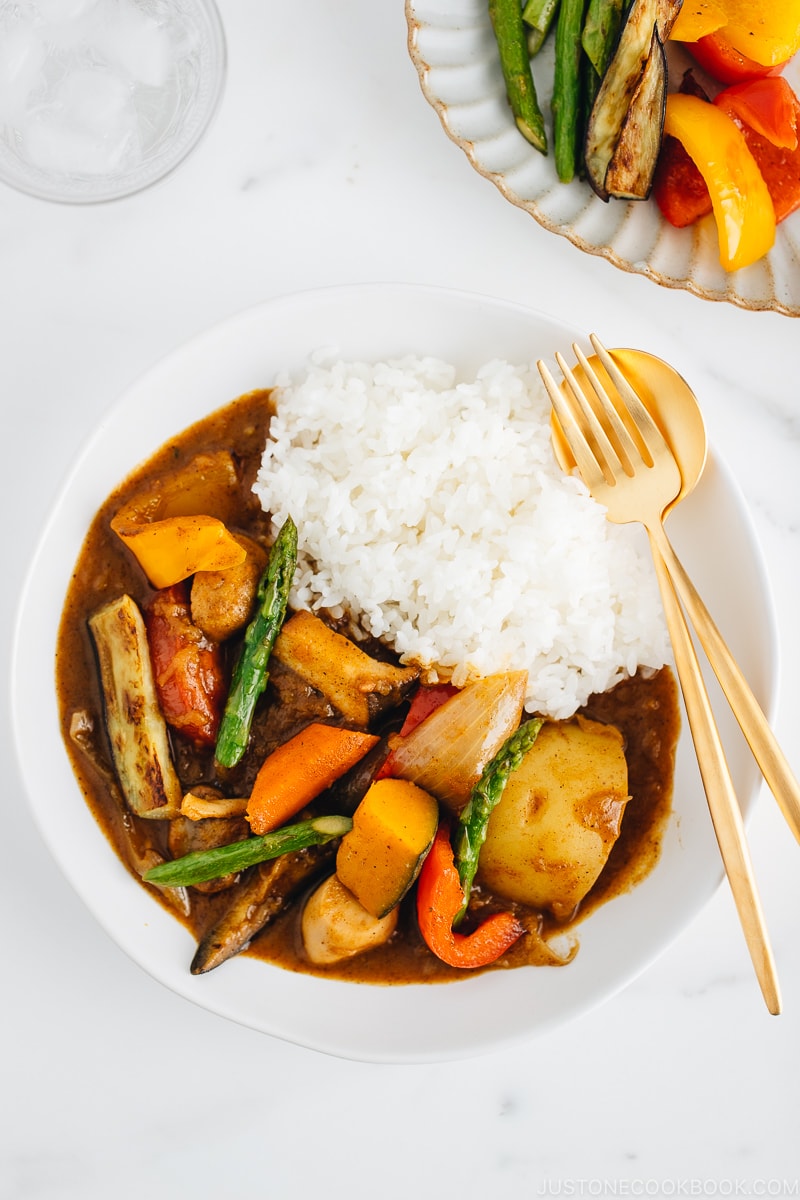
I received a lot of requests from JOC readers to make a Vegetarian Japanese Curry recipe. Sure, you can throw in chopped veggies in the mix and call it Vegetarian Curry. Instead, I spent a little more time developing one killer version that I am truly excited to share.
It’s one pot of curry that makes the most use of vegetables, and perhaps steals the limelight of the regular curry!
Table of Contents
What’s So Good About This Vegetarian Japanese Curry?
- Big bold layers of flavors, even without meat!
- Nutritious and healthy, with lots of veggies!
- Fulfilling, without too heavy on the stomach.
- Striving to eat more plant-based food? This recipe is going to be your staple.
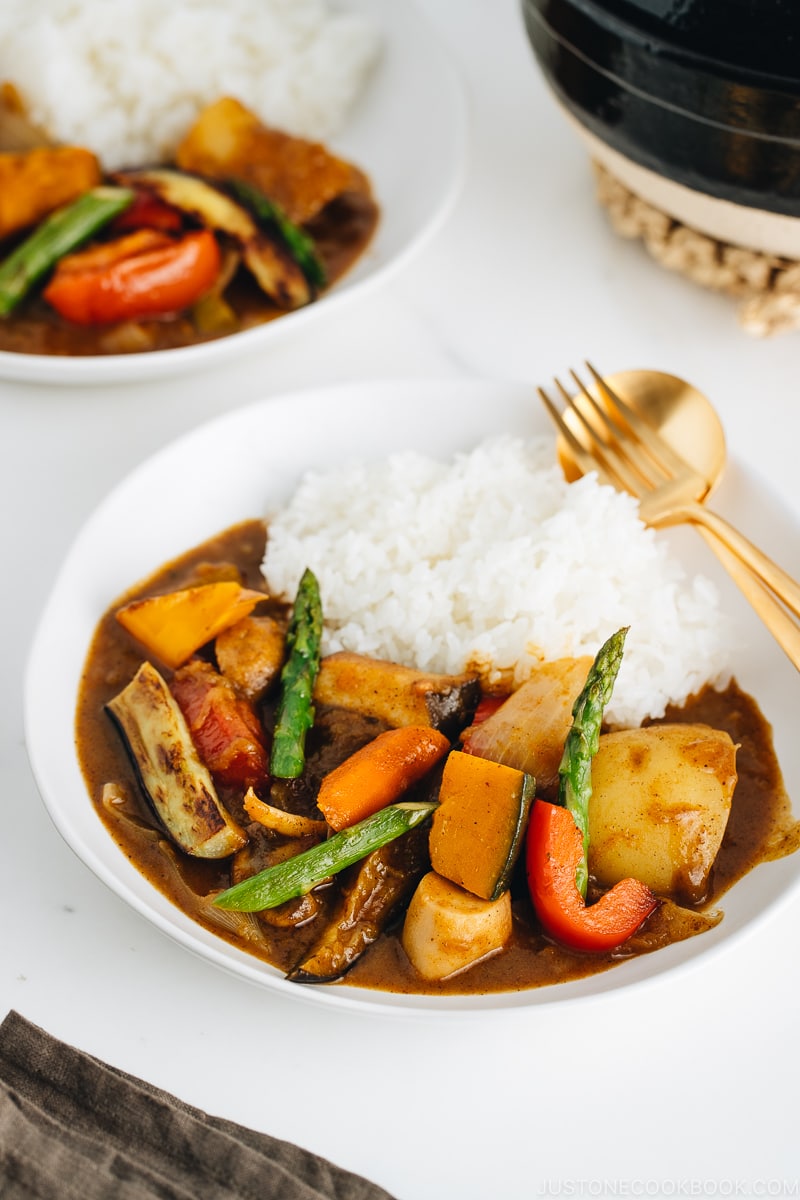
Bring Regular Curry to The Next Level
The most challenging part of making vegetarian curry in a big pot is that each vegetable has different cooking times.
You can somewhat control by cutting the vegetables into desirable sizes and toss them in, so they are cooked into homogenous tenderness. For this recipe, however, I decided to take on a different approach.
First, I categorized the ingredients based on the texture and density. For this instance, I grouped onions and root vegetables together as they have similar cooking time. Then, I applied a mix of sauteeing and steaming methods to cook them in my Dutch oven pot. Once they are almost 80% tender, I added broth and continued cooking for a short time. Next, I used a separate frying pan and sauteed the rest of the vegetables in stages.
With this approach, each ingredient maintains its shape beautifully. No crumbling potato pieces or overly soft peppers. Because I cooked the vegetables and mushrooms in a separate pan, they get a nice char like how you’d sear meat and ultimately brings additional flavors to the curry.
5 Tips on Making This Curry
- Make homemade Japanese curry roux – You can buy an S&B Golden Curry Sauce Mix (no meat contained) and use the half box for this recipe, but I highly recommend making the roux from scratch at home!
- Cook the ingredients in stages – Divide your ingredients into dense vegetables, tender vegetables, and mushrooms, and cook them in stages.
- Use king oyster mushrooms – The unique meaty texture of this mushroom lends a great chewy bite and incredible umami. It’s definitely the most delicious type of mushroom to use for Japanese curry. If you can’t find king oyster mushrooms, you can use large portobello mushrooms.
- Don’t overcook each ingredient – Vegetables get mushy and disintegrate easily as you continue to cook. Therefore, it’s important to retain the shape and texture by not overcooking them.
- Top the curry with colorful vegetables – To bring out the color of the curry, I recommend keeping some colorful vegetables you sautee for plating later. The vibrant green, orange and yellow contrasts beautifully on a brown sauce.
Ingredients Substitutes and Suggestions:
This recipe is pretty flexible when it comes to swapping ingredients.
- Vegetables: cauliflower, corn, green beans, okra, zucchini, and etc.
- Mushrooms: Crimini mushroom, portobello mushroom, shiitake mushroom, and etc.
- A meat-eater in the family? You can put Tonkatsu (baked version) or Chicken Katsu (baked version) on top!
How to Make it Vegan
I make the curry roux with butter and saute the mushrooms with butter for the flavors. If you want to make this dish vegan-friendly, simply swap the butter with vegan butter or other types of oil.
Enjoy the Japanese vegetarian curry over rice. It’s going to be the most exciting, satisfying meal you’d love for a very long time.
Other Japanese Curry Recipes You May Want to Try
- Sapporo Soup Curry
- Cold Curry Udon
- Pressure Cooker Japanese Curry
- Pressure Cooker Japanese Seafood Curry
- Japanese Chicken Curry
- Japanese Beef Curry
- Curry Udon
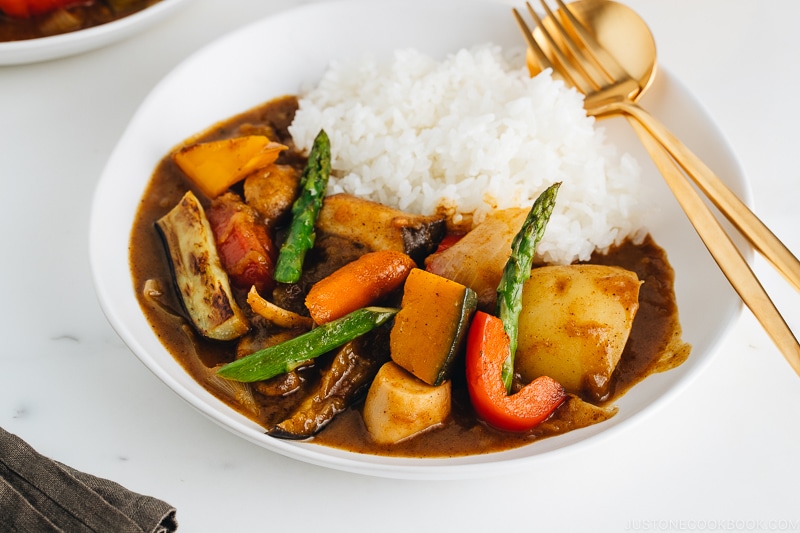
Wish to learn more about Japanese cooking? Sign up for our free newsletter to receive cooking tips & recipe updates! And stay in touch with me on Facebook, Pinterest, YouTube, and Instagram.
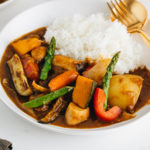
Vegetarian Japanese Curry
Video
Ingredients
For the Homemade Curry Roux
- 3 Tbsp unsalted butter (or use vegan butter or oil for vegan)
- 4 Tbsp all-purpose flour (plain flour) (or use GF flour for gluten-free)
- 1 Tbsp Japanese curry powder (I recommend S&B Curry Powder; available on Amazon)
- 1 Tbsp garam masala
- ¼ tsp cayenne pepper (optional; omit for a milder heat level)
For the Ingredients
- 1 onion (10 oz, 280 g)
- 2 Yukon gold potatoes (9 oz, 260 g)
- ⅛ kabocha squash (seeds removed; 5 oz, 140 g)
- 1 carrot (3 oz, 85 g)
- 1 tsp ginger (grated, with juice; from 1-inch, 2.5-cm knob)
- ½ red bell pepper (4 oz, 110 g)
- ½ yellow bell pepper (4 oz, 110 g)
- 8 asparagus spears (5 oz, 140 g)
- 1 Japanese eggplant (4 oz, 115 g)
- 4 king oyster mushrooms (eringi) (5 oz, 140 g)
- ½ shimeji mushrooms (3.5 oz, 100 g)
- 4 button mushrooms (2 oz, 60 g)
- 1 tomato (5 oz, 150 g)
For the Condiments and Seasonings
- 3 Tbsp extra virgin olive oil (divided in thirds)
- 3 cups vegetable stock/broth (or water)
- 1 bay leaf
- Diamond Crystal kosher salt
- freshly ground black pepper
- 1 Tbsp unsalted butter (or use vegan butter or oil for vegan)
- Japanese curry roux (use the ingredients above and instructions below to make homemade; or use 3.5–4 oz, 100–115 g of store-bought roux)
- 1 apple (8 oz, 220 g)
For Serving
- 4 servings cooked Japanese short-grain rice (minimum 1 cup, 180 g per serving)
Instructions
- Gather all the ingredients.
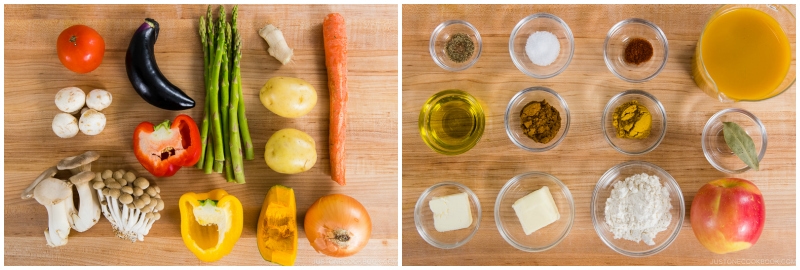
To Make the Homemade Curry Roux
- Preheat a small saucepan over medium heat. Then, add 3 Tbsp unsalted butter and melt it completely. Once the butter is melted, add 4 Tbsp all-purpose flour (plain flour).
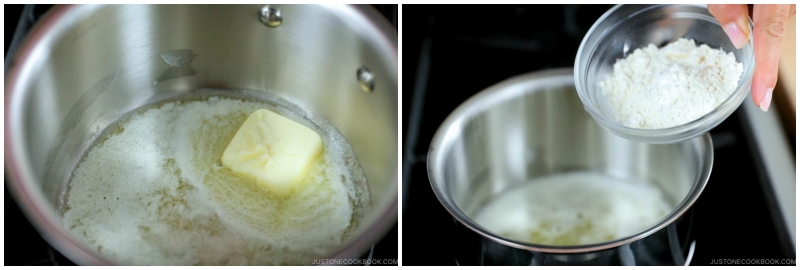
- Reduce the heat just slightly. Combine the flour and butter by stirring continuously with a silicone spatula. The mixture will start to fuse and swell but will eventually become more liquid in form. Now, reduce the heat to low and stir for 15 minutes to cook the flour.

- The mixture will darken to a chocolate color after 12–15 minutes.
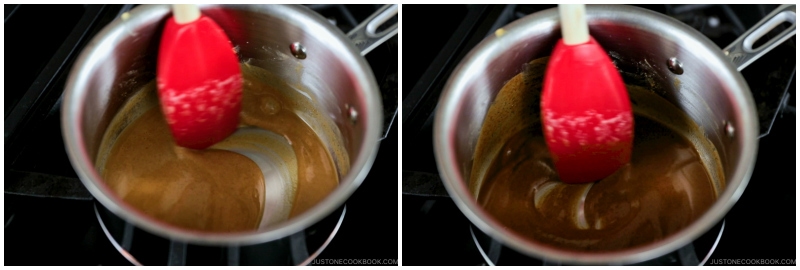
- Then, add 1 Tbsp Japanese curry powder and mix well.
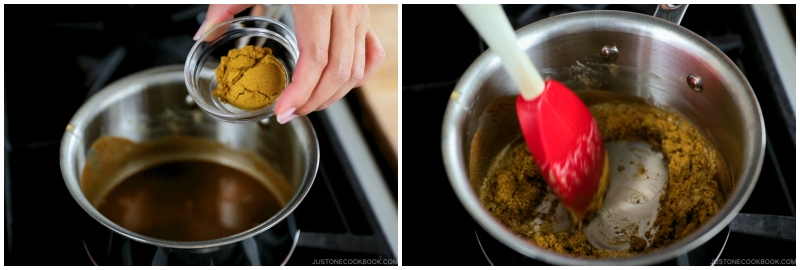
- Next, add 1 Tbsp garam masala and ¼ tsp cayenne pepper (optional).
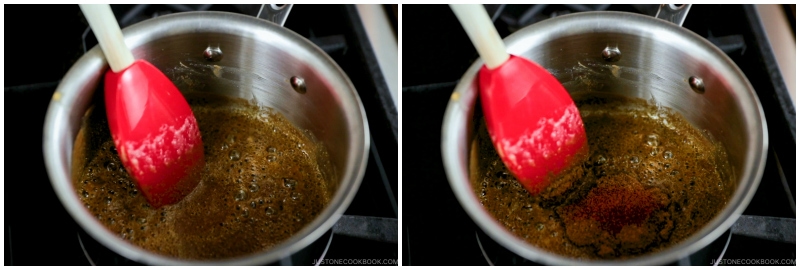
- Mix well to combine and cook, stirring, for 20 seconds. Transfer the roux to a bowl and set aside.
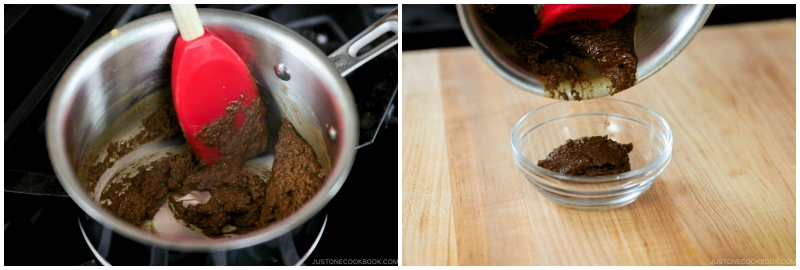
To Prepare the Ingredients
- Cut 1 onion in half and cut each half into 4 wedges.
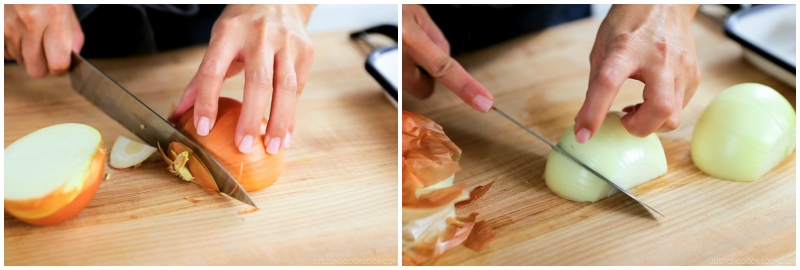
- Cut 2 Yukon gold potatoes into quarters and soak them in water to remove the starch, for about 10 minutes. Tip: For Yukon gold potatoes, I leave the peel on.
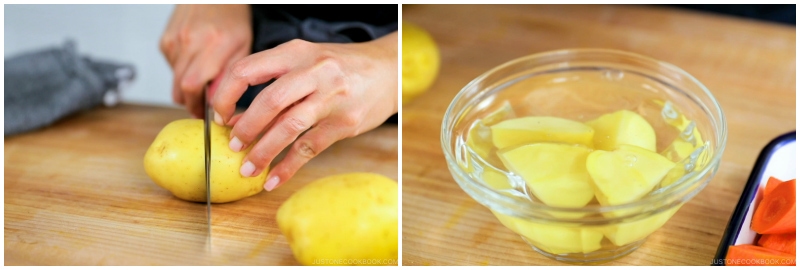
- Cut ⅛ kabocha squash into 1-inch (2.5-cm) cubes.
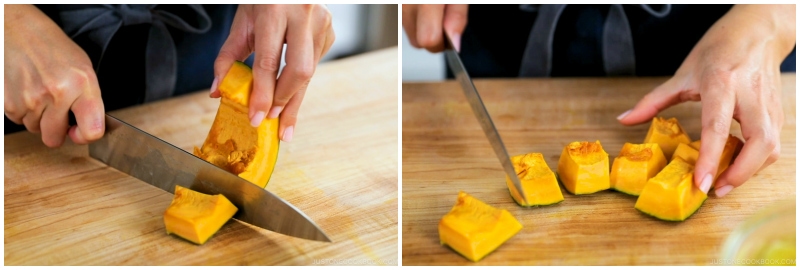
- Cut 1 carrot in the Japanese rangiri style. Grate the ginger and measure the amount 1 tsp ginger (grated, with juice).
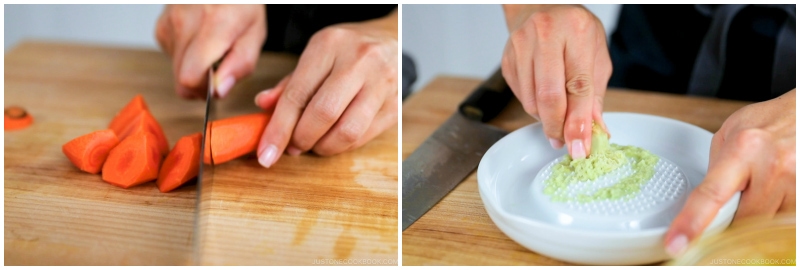
- Cut ½ red bell pepper and ½ yellow bell pepper into small strips.
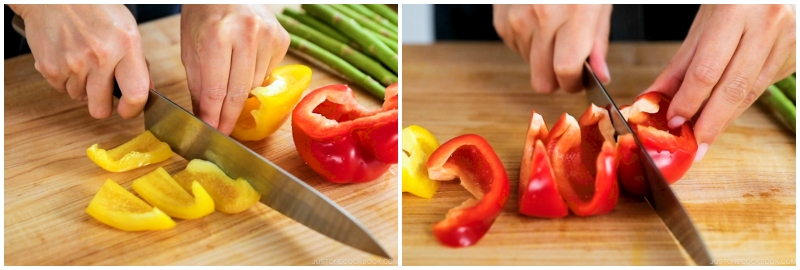
- Discard the tough bottom ends of 8 asparagus spears (you can snap off the tough end with your fingers) and cut them diagonally into 2-inch (5-cm) pieces.
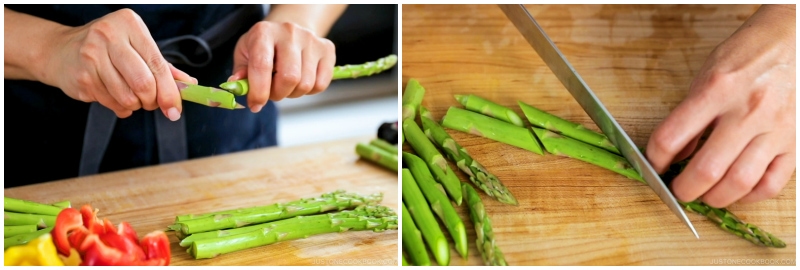
- Cut 1 Japanese eggplant in half crosswise and cut each half into wedges. Soak them in water for 10 minutes to remove the astringency and prevent discoloration.
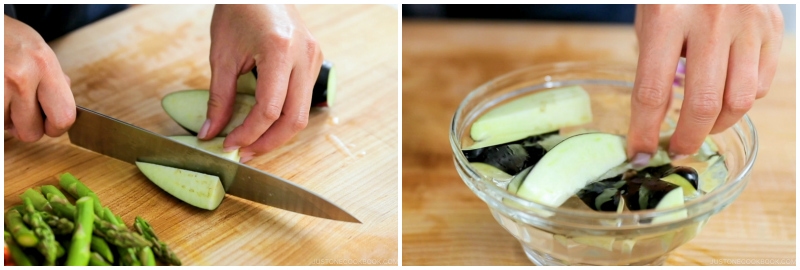
- Cut off the ends of 4 king oyster mushrooms (eringi) stems and cut the mushrooms into 1- to 2-inch (2.5- to 5-cm) pieces.
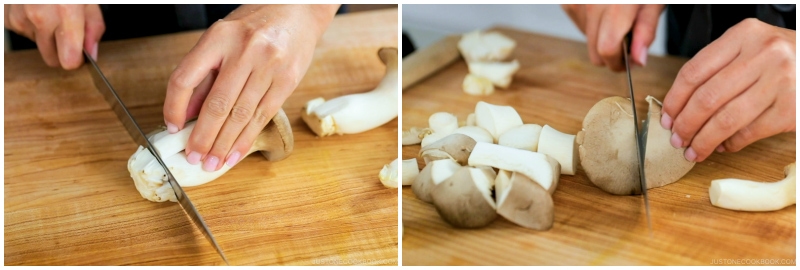
- Discard the bottom of ½ shimeji mushrooms and separate them into clumps. Cut 4 button mushrooms in half.
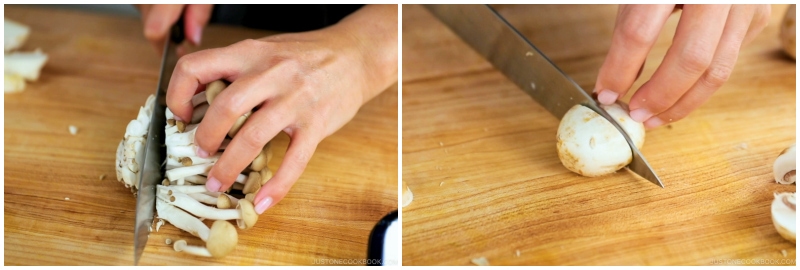
- Cut 1 tomato into 6 wedges.
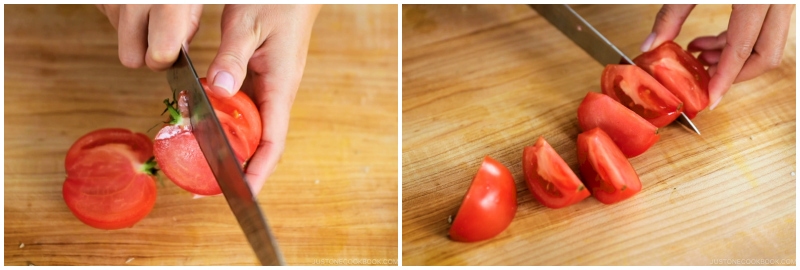
To Cook the Curry
- Preheat a large pot (I used a 4.5 QT Dutch oven) over medium heat. Once hot, add one-third of the 3 Tbsp extra virgin olive oil. Then, add the dense vegetables (onion, potatoes, kabocha, and carrot) to the pot. With a spatula, mix and coat the vegetables with the oil, about 1 minute.
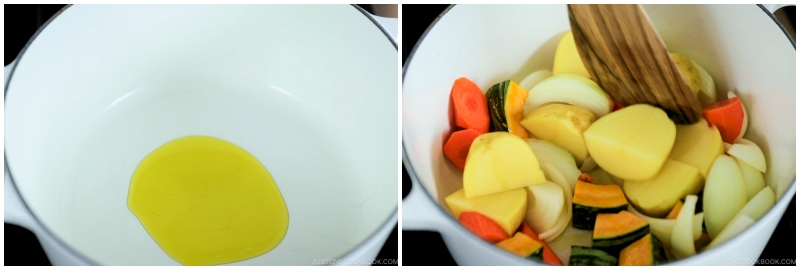
- Add the grated ginger and mix. Cover with a lid and reduce the heat to low. Let the vegetables steam for 15–20 minutes (we use the steaming method to keep the ingredients‘ shape instead of the boiling method). Meanwhile, you can start stir-frying the vegetables (Step 6).
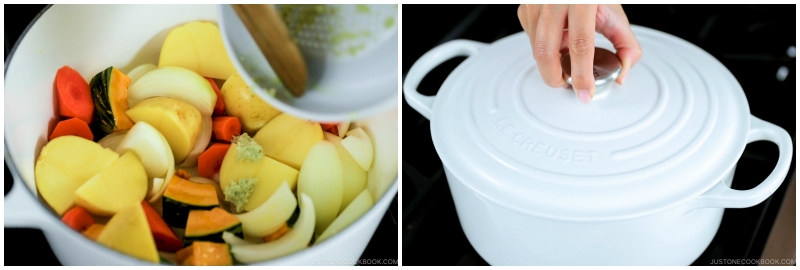
- Once in a while, shake the pot so the ingredients at the bottom don‘t burn. After 15–20 minutes, insert a skewer and check if the vegetables are 80% cooked.
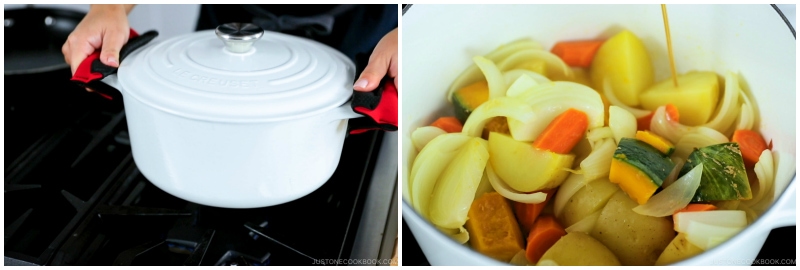
- Add 3 cups vegetable stock/broth and 1 bay leaf. Bring it to a boil on medium heat.
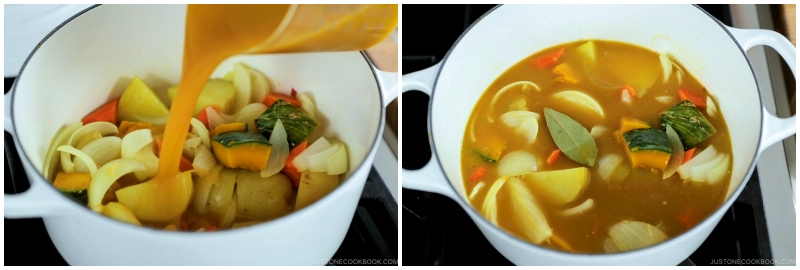
- Once boiling, skim the scum and foam on the surface and cook for 3 minutes. Insert a skewer to check that the hard vegetables, like the potatoes and carrot, are done. Once the vegetables are cooked through, turn off the heat.
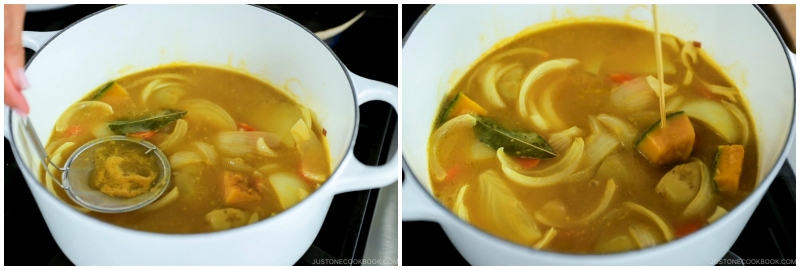
- Preheat a large frying pan over medium heat. Once hot, add another one-third of the olive oil. Then, add the eggplant.
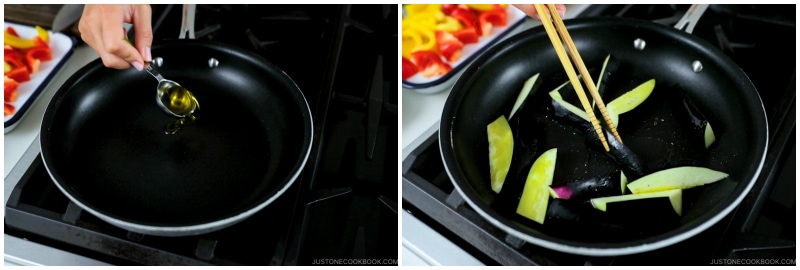
- Cook the eggplant pieces until nicely brown, about 8–10 minutes, and transfer them to a plate.
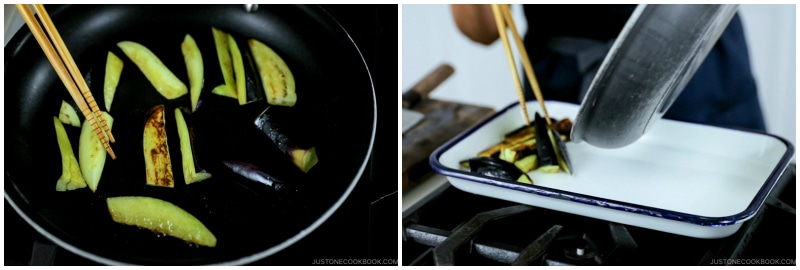
- In the same pan, add the remaining olive oil. Then, add the bell pepper and asparagus.
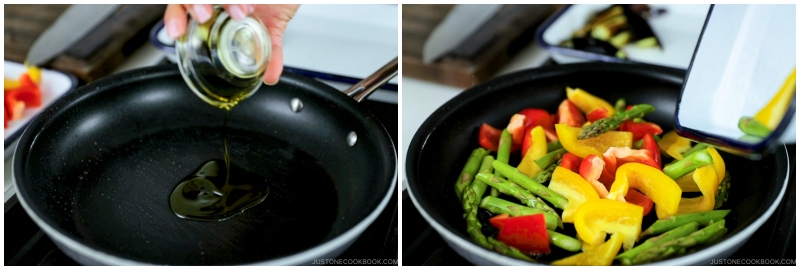
- Sauté the vegetables until tender, about 6–7 minutes. Season with Diamond Crystal kosher salt and freshly ground black pepper and transfer them to the plate.
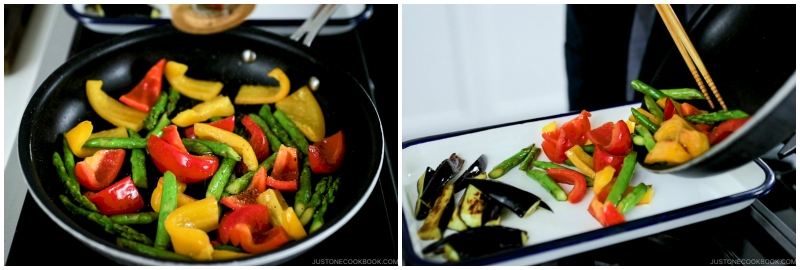
- In the same pan, heat 1 Tbsp unsalted butter and sauté all the mushrooms, about 4 minutes.
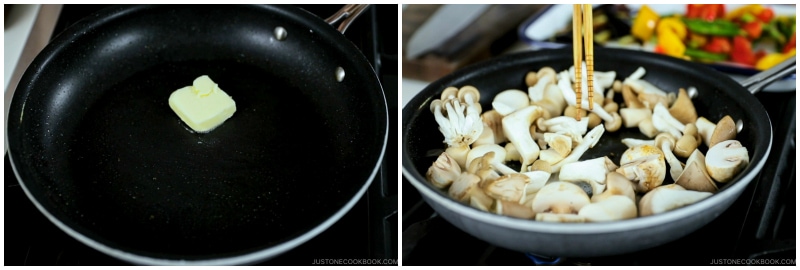
- Season with Diamond Crystal kosher salt and freshly ground black pepper and remove from the heat. Set aside.
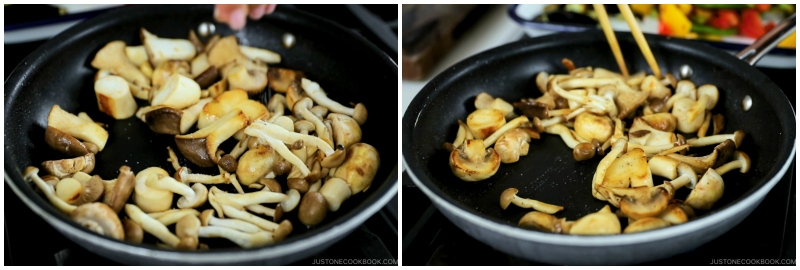
- Bring the pot back on the stove over medium heat and bring it to simmer. Once the broth is simmering, remove the bay leaf from the pot (optional). Add the mushrooms to the pot.
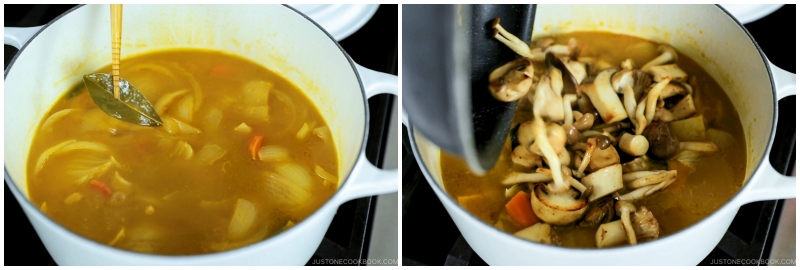
- Add the vegetables to the pot and gently mix it all together. Tip: Instead of adding all the vegetables, I recommend reserving some of the colorful vegetables for toppings later.
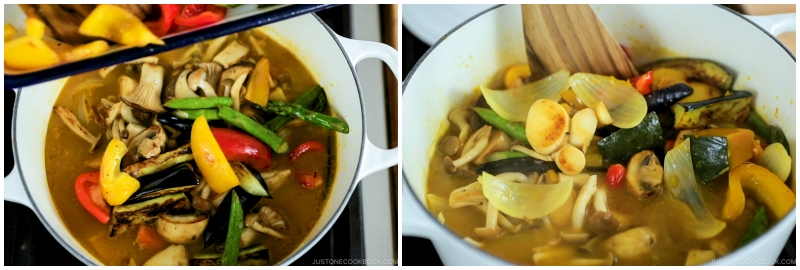
To Make the Curry Sauce
- When the broth is heated through, turn off the heat. Gradually add a small amount of the homemade Japanese curry roux (or 1–2 cubes store-bought roux) to your ladle along with some hot broth. Let the roux dissolve completely in the ladle before releasing it to the broth. Repeat to dissolve the remaining curry roux. Taste the sauce and adjust by adding more broth or more curry roux (I used all the homemade roux). Then, turn the heat back on and bring it to a gentle simmer again.
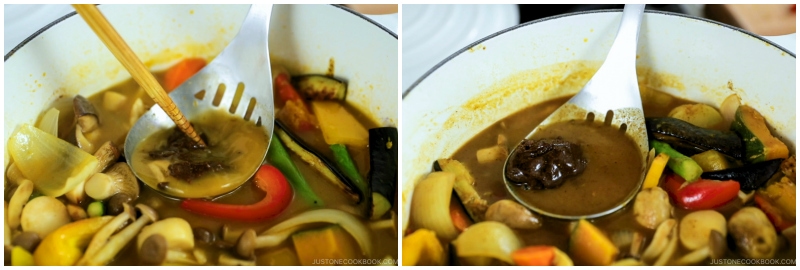
- Grate 1 apple and add it to the curry (adjust the amount of sweetness as you like). Mix gently without breaking up the vegetables.
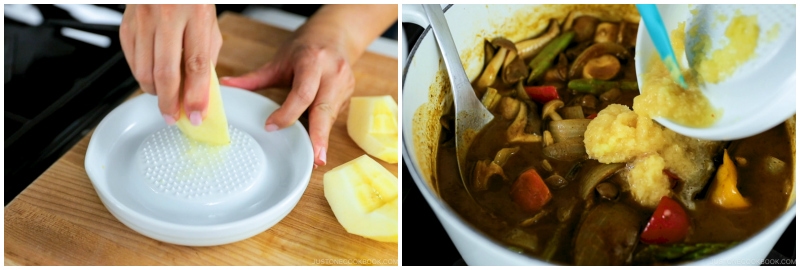
- Taste the curry (it’s very important!) If needed, add more apple and season with salt. Sometimes, just a pinch of salt can bring out more flavors.
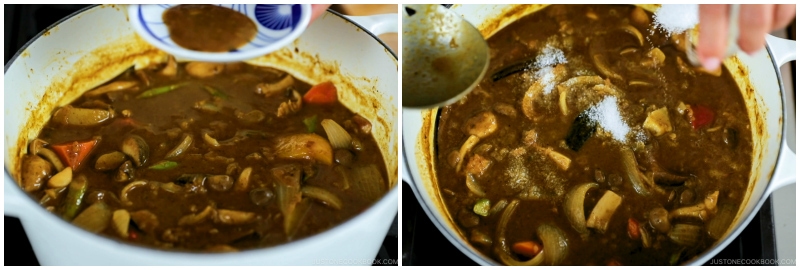
- Taste again. When you‘re done adjusting the seasoning, add the tomato. Now, the curry is ready to serve!
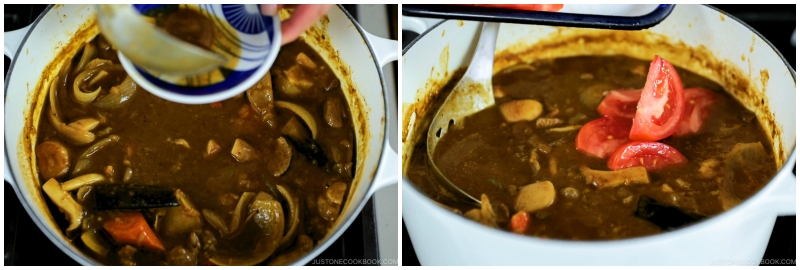
To Serve
- Divide 4 servings cooked Japanese short-grain rice and place to one side of each individual serving plate. Pour the curry on the other side. Add a few colorful vegetables you saved on top of the curry.

To Store
- You can keep the leftovers in a glass airtight container (to avoid stains) and store it in the refrigerator for up to 3 days and in the freezer for a month. The texture of the potatoes will change in the freezer, so you should take them out before freezing. Defrost the frozen curry in the refrigerator for 24 hours before you want to reheat it.
To Reheat
- Leftover curry sauce will thicken into a paste as it cools, so it tends to burn while reheating. To avoid this, stir ½ cup (120 ml) water or more into the leftover sauce until loosened. Then, gently reheat it on low heat. If the sauce seems thin, continue heating with the lid off to reduce the sauce.
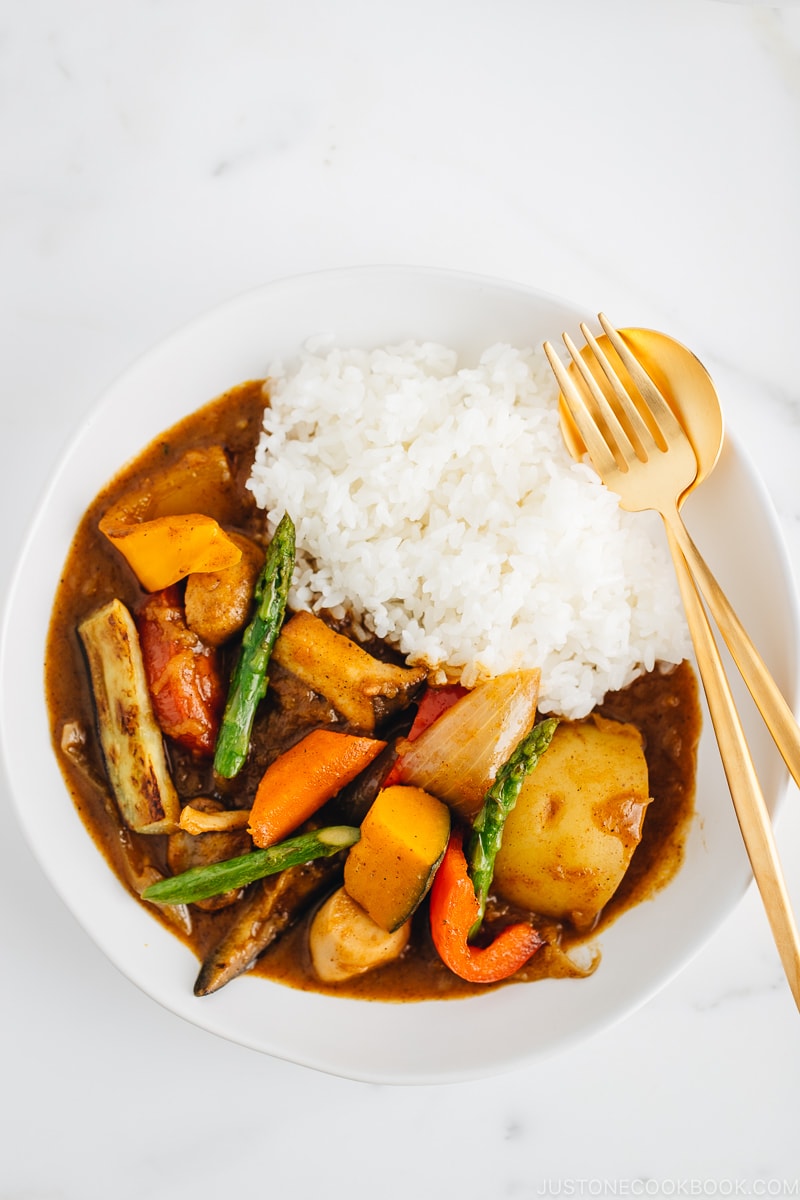
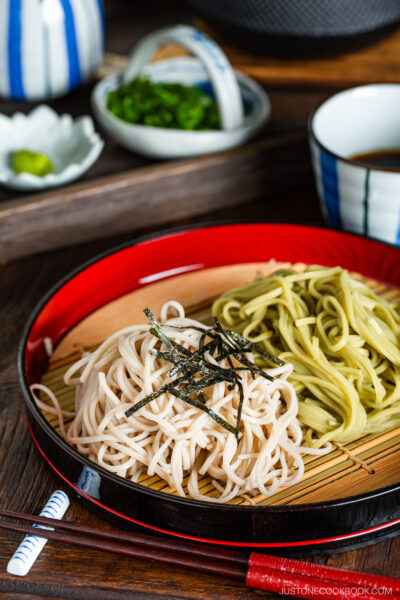
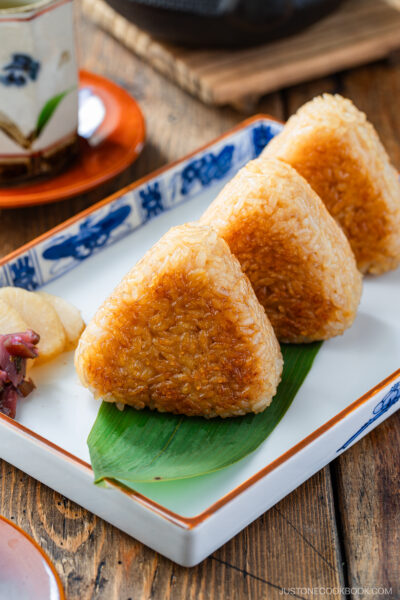
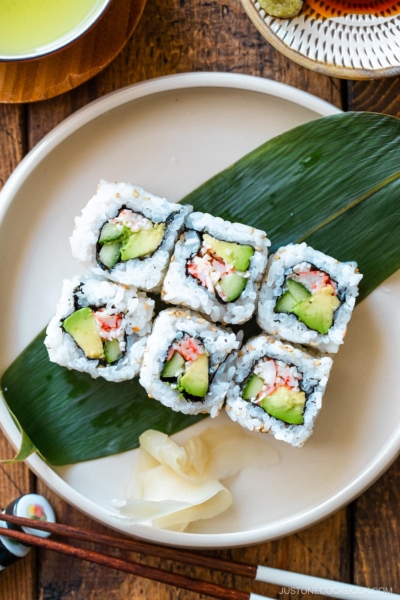
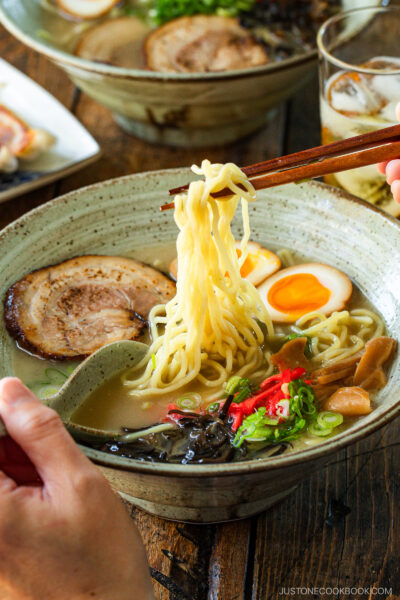




this japanese curry is so good! Perfect for the cooler weather, love the mix of the stewed and sauteed vegetables. I made the fresh roux and it came out great
Hi B.R.! Aww. 🥰 We are so happy to hear you enjoyed Nami’s recipe.
Thank you for trying her recipe and for your kind feedback!
Hi, how exactly do you calculate nutrition? As in for what amount of foor is the nutrition value given? I assume one portion but wanted to make sure. And does the calculation include rice or no?
Hi, Anna! Thank you for reading Nami’s post.
Nutrition data is calculated for approximately one serving. This recipe includes the cooked rice in the data.
Please use this information as a guide.
May I replace the potatoes with sweet potatoes? Will they survive the freezing process better? Also, would it be okay to add some chickpeas to the veggie mix to make a more complete protein when served with rice?
Hi Cybèle, Thank you for using Nami’s recipe. You can use sweet potatoes and freeze the curry, but the texture will be similar to potatoes when reheated. The addition of chickpeas or other vegetables is optional. As Nami explains in this post, this recipe is pretty flexible when it comes to swapping ingredients, so feel free to adjust the recipe to your liking and enjoy the curry!🤗
This was so delicious and comforting on a snowy Saturday! I used two curry cubes and it came out perfectly. Thank you for a great recipe!
Hi Laura! We are so happy to hear you enjoyed Nami’s vegetarian curry recipe!
Thank you so much for trying her recipe and for your kind feedback.
Happy Cooking!
i’d love to try this but using the pressure/instant cooker. at what stage would you drop the asparagus in? and have you tried it with canned asparagus?
Hello there, Arwa! Thank you for taking the time to read Nami’s post.
We recommend combining the asparagus, bell pepper, and other vegetables after you’ve finished all of the other presser cooking.
Because canned asparagus is already cooked and soft, you may add it at the very end when you add the curry roux.
We hope this was helpful!
Hi there,
Is there a reason the ratios of curry powder/garam masala are different between recipes? I tried to double the vegetarian curry recipe (where it was 1 tbsp of curry powder/1 tbsp of garam) and it ended up being too much garam masala for my taste, but in the regular curry roux recipe, the ratio is different (4 tbsp of curry powder/1 tbsp of garam masala). Thank you!
Hi, gabby! Thank you so much for trying Nami’s recipe!
Nami alters the mix’s ratio according to the ingredients and/or cooking methods used. So she used a 1:1 ratio for this curry dish.
As for the curry roux recipe, Nami just revised the recipe and improved it with a new ratio.
We hope this helps!
Made this today. Loved it. Did use box curry roux.
Hi Fiona! Thank you for trying Nami’s recipe and for your kind feedback!
We are glad to hear the box curry roux worked out well for you!
Happy Cooking!
Delicious!! This was the first time I used a roux in a curry recipe and I happily discovered that it adds some kind of creaminess to the whole! I just made some slight changes: I cooked all the ingredients in the same pot and in batches based on their density (this is same as you), each batch like this: cook until brown, deglaze and reserve apart. Cooking each type of vegetable the right time is key to preserve their original flavor. Also, I applied some heat to the spices in a separate pan before adding them to the pot just to “wake them up” and get a more intense flavor.
Hi Maribel! We are so happy to hear you enjoyed Curry!
Thank you for experimenting with Nami’s recipe and sharing your experience with us.
Happy Cooking!
I’ve made your chicken curry and loved it! Now I want to try this one because of the variety of vegetables, but I’d also like to add chicken. In which step would you suggest I add it? Thanks!
Hi Katherine! Thank you very much for trying Nami’s recipes!
You can add chicken at step 1 and brown the outside of the chicken, then take it out. Then continue step 1 to cook the veggies. In step 2, put the chicken back on top of the veggies and follow the rest of the instructions. We hope this helps!
Wow, this recipe took me a long time (3 hours, not 1.5). I think steps could have been done in conjunction to speed it up (ie: while hard veggies cook, saute the eggplant and others). I found the curry to be a little bland and given the amount of time it took to make – I was a bit disappointed.
Hi fandolis, Thank you very much for trying Nami’s recipe.
We are sorry to hear this recipe made you disappointed. We reviewed the recipe and include the cooking time for homemade curry roux.
As for the flavor, if you use curry powder that is not Japanese curry powder, it might taste different. So please feel free to add spices as you like.
Here is more detail about Japanese Curry Powder: https://www.justonecookbook.com/japanese-curry-powder/
We hope with your adjustment, enjoy homemade vegetarian Japanese Curry. 🙂
When my doctor told me to quit eating gluten, I looked for ways to adapt Japanese curry to fit my new diet. My dad is half Japanese, so I grew up eating curry and loved it. I was so lucky to find your recipe and make my own roux! I used a King Arthur gluten-free all purpose blend without xantham gum, and it worked well. Although, I cooked the flour in the butter for 7-8 minutes instead of 12-15. Gluten-free flour can be a bit sweet if it contains rice flour, so I’d caution gluten-free folks to add less grated apple than they think they need. All in all, this recipe worked well and tasted great! I look forward to making it again!
Hi Heather! Awesome! Thank you very much for trying Nami’s recipe and sharing your cooking experience with us.
This information will be very beneficial to many other readers! Thank you!💝
I had yet to try this vegetarian curry of yours until needing to make a dish for a vegetarian friend so I finally had a reason, and I should not have delayed so long! I think this is the first Japanese curry I’ve made that also had garam masala and I feel like that might have made it taste closer to Coco Curry. Loved the variety of veg; reminded me of Curry Samurai with their massive number of types of veg in their curry. Will for sure make again!!
Hi Janelle! We are so glad to hear you had a chance to try this recipe and you enjoyed the flavor!
Thank you very much for trying Nami’s recipe and for your kind feedback.
What exactly is Curry Powder? We make a lot of Indian food, so we have a fair amount of spices around. Which are typically used for the curry powder?
Hi Mohammed! Thank you very much for reading Nami’s post!
Nami uses S&B curry powder (https://amzn.to/2FyHBsS Ingredients listed on their site) and curry powder from a local Indian grocery store.
We hope this helps!🙂